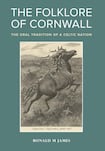
Ronald James believes firmly in the shifting and ever malleable properties of national culture. In his new book, Folklore of Cornwall: the Oral Tradition of a Celtic Nation, he rightly writes critically of the quite dated belief whereby a nation’s folklore leads infallibly back to Iron Age conceptions of an original form of its culture. Such a belief tends to be held by cultural nationalists who oft are left disillusioned and even irate by a discovery that their “unique” folkloric heritage inevitably will have been cross-pollinated by elements of the culture of other nations.
Folklore-induced disillusionment, though, is unreasonable, and so Ronald James’ concluding remark serves as an optimistic reminder that any nation might take pride in its own way of reconciling varied cultural elements from the past. Cornwall, for example, though labelled a “Celtic nation” in the book’s title, is also demonstrated by James’ work to incorporate within its folklore a variety of traditions ranging from pre-Celtic, to Anglo-Saxon, and to Scandinavian, with repertorial links to northern France and to eastern Europe along the way. 19th- and 20th-century editions of Cornish folklore have since been exported to the American “Wild West”, a by-product of the emigration culture which also has been responsible for the modern-day availability of the Cornish pasty worldwide.
Whereas novelist Charlotte Brontë’s Irish origins were partially obscured by her father’s decision to rework the spelling of the family name Prunty, from the Irish Ó Pronntaigh, to Brontë, Ronald James reveals her masterpiece Jane Eyre to have had its origins in a Cornish folktale to which she would have had access via her mother’s side of the family who were from Cornwall. This suggestion on James’s part ties within an age-old tradition whereby the motifs and storylines of a selection of the canons of English literature have at various times been attributed to contact with Celtic storytellers – Gulliver’s Travels by Jonathan Swift is yet another case in point. The same rule of cultural cross-pollination goes for literary works in the English language, then.

As a Celtic nation, mention of Cornwall merits mention of its very own Celtic language heritage, which as early as 1665 had suffered a mortal blow with the death of monoglot speaker Cheston Marchant, an event which preceded by a few decades the disappearance of Cornish as a community language. The language has since seen a revival, a fact underlined by a Cornish song’s success in winning the 2015 Pan Celtic Song Contest, but neither the decline of the Cornish language nor attempts at its revival feature in James’ book on Cornish folklore whose mention of any expression of Cornish language culture is limited to references to Jowan Chy-an-Horth, py, An try foynt a skyans which is mentioned thrice and Nebbaz gerriau dro tho Carnoack mentioned once.
He does, however, cite instances of Cornish English, underlining its difference from standard English by describing some of the translation issues around interpreting the phrase “we yen” which traditionally announced the beginning of the celebration of the end of harvest – the phrase can mean “we have him” or “we have ended”, depending on which 19th-century scholar you care to trust. In fact, interest in Cornish English as a separate dialect too has led to the preservation of a certain amount of Cornish folklore as part of a 1913 publication by the name of Rustic Speech and Folklore by Mary Elizabeth Wright.
However, the overwhelming use of English in compiling works of Cornish folklore through the centuries has led to a situation whereby Cornish folklore has been conflated with the folklore of English-speaking Britain at large. I would further wager that conflating Cornish folklore with that of its anglophone neighbours has been partly responsible for the Cornish dearth of collected material much lamented by James but who does not, however, make this connection. Rather, he points to the Irish National Folklore Collection which he sees as providing a precedent for English as a perfectly acceptable medium of expression for Celtic folklore.
And whereas James avoids the wrath of the proudest Cornwallian by consistent insistence on Cornwall’s separate identity from England, his references to the folklore of “Northern Ireland” seem unnecessarily anachronistic in the context of a publication whose historical and cultural scope reaches far beyond the borders of partition.

James’s body of work certainly raises questions worthy of further investigation of the politics of Cornish and Celtic folklore. A counterpoint to what appear to be his own convictions is made available via an engagement with the class-conscious anthropology of Paul Manning, author of a capitalist critique of a situation wherein Cornish folklore thrived amidst the perils of mining for tin and copper. James’s suggestion that industrialisation came without negative effects for folklore and traditional culture might be read as a couched defence of a capitalist system which undeniably has decimated local expressions of identity. The fact that Cornish mineworkers in the US managed to maintain a degree of diasporic engagement with their heritage, for James, is a case study in the vitality of folk culture, rather than a cause for concern that so many of them should find themselves having to emigrate, their presence now distilled to mere images of tommyknockers who grin from the vantage point of bottles of American craft ale.
Either way, Ronald James' study of Cornish folklore is an apt introduction both to Cornwall and to folklore, a field which thrives on locating links between storytelling cultures. James' innovative contribution to this field is a comparative study, in an international context, of legends, folktales and memorates from Cornwall, involving droll tellers, mermaids, piskies, giants, bridegroom spectres, and tommyknockers. His sources range from the antiquarian writings of 18th-century eccentrics to "the website known as reddit". The newcomer to folklore is left under no uncertainty as to the difference between legends (stories told to be believed) and folktales (intended as fictional narratives) which in a pedagogical fashion are repeatedly defined whenever these terms become involved in the discussion. The advanced folklorist is glad for Cornwall.
Dr Seaghan Mac an tSionnaigh lectures at the University of Uppsala, Sweden and at Queen's University, Belfast











